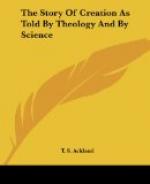The carboniferous strata form the second of our landmarks. They seem to point to the fulfilment of the command that the earth, should bring forth vegetation. There is, however, one point which requires some notice. The Mosaic account, as we read it in our English Bibles, seems to be limited to phanerogamous plants— grass, the herb yielding seed, and the fruit-tree yielding fruit. Now, it is a well-known fact that the great mass of the vegetation, the remains of which constitute coal, consisted of cryptogamic plants, which do not produce seed, properly so called, but only spores; the distinction being that the spore contains the germ and nothing more, while in the seed the germ is provided with a store of nutriment to assist in the earlier stages of the development of the plant. What appears to be a farther discrepancy, the absence of any traces of the grasses, leads in reality to the solution of the difficulty.
The word which is translated “grass” [Hebrew script] means in reality, any fresh sprout. Now it is remarkable that Moses specifies three kinds of vegetation, with regard to two of which it is noted that they produce seed, while nothing is said of the seed of the remaining class. Grass too, is really a herb bearing seed, and, as such would be included in the second class, and there would have been no occasion, to mention it separately. It would appear then that the first class consisted of seedless plants, i. e. of the cryptogamia. This conclusion is strengthened when we turn to verses 29 and 30. If the word [Hebrew script] were correctly translated “grass,” we should certainly expect to find it in those verses, since the grasses contribute more to the food of both man and beast, than all the other herbaceous plants put together. This omission then, is an indication that the word, as used in this chapter, denotes a class of plants which are not commonly employed for food, and this condition also is fulfilled in the cryptogamia.
There are then four special points in this period, of which two seem to correspond with the Mosaic record, while the other two are unnoticed in it. The two points of correspondence are the upheaval of the dry land, and the prevalence of a very abundant and luxuriant Flora. As in the case of the fifth and sixth days, the words used with reference to land plants seem to denote a period of remarkable development, rather than the first appearance. The two points unnoticed are the beginnings of animal and vegetable life. In the case of animal life the omission has already been accounted for. The beginning of vegetable life was probably contemporaneous with that of animal life, for each is necessary to the other, since the food of the animal must be prepared by the vegetable, and after being used by the former returns to a state in which it is fitted for the nourishment of the latter. As animal life commenced in the ocean, so in all probability did vegetable life, though no certain traces of it are found in the earliest rocks; but this is easily accounted for by the very perishable character of the simpler forms of algae. Like the earliest animals, the first algae were probably microscopic plants, and the omission of any mention of them was therefore inevitable.




